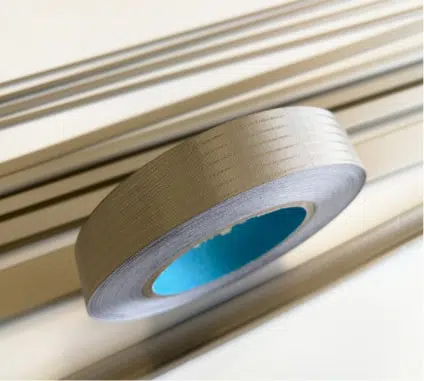 Conductive fabric tape constitutes a unique material combining the attributes of textiles and conductive materials. It comprises woven or non-woven fibers, which undergo coating or infusion with conductive elements like copper, silver, or carbon. The tape possesses an adhesive stratum on one side, facilitating its effortless application to a variety of surfaces.
Conductive fabric tape constitutes a unique material combining the attributes of textiles and conductive materials. It comprises woven or non-woven fibers, which undergo coating or infusion with conductive elements like copper, silver, or carbon. The tape possesses an adhesive stratum on one side, facilitating its effortless application to a variety of surfaces.
The Functioning of Conductive Fabric Tape
- Conductive Fibers: Conductive fabric tape’s functionality resides in its conductive fibers. These fibers allow the tape to transmit electrical signals or current, rendering it a fitting choice for countless electronic applications. The conductive element employed in the fibers dictates the tape’s overall conductivity and performance.
- Adhesive Layer: The adhesive layer on conductive fabric tape enables its seamless application to an array of surfaces, encompassing those with irregular shapes or contours. This characteristic renders the tape highly versatile and adaptable for various applications.
Conductive Fabric Tape Applications
- EMI shielding: One of the predominant applications of conductive fabric tape is electromagnetic interference (EMI) shielding. The tape can be affixed to electronic components, devices, and enclosures to safeguard them from EMI, which can deteriorate performance or induce malfunctions.
- Grounding: Conductive fabric tape can also serve grounding purposes, providing a robust and dependable connection between electronic components and a ground source. This can contribute to the secure and stable operation of electronic devices.
- Wearable technology: Owing to its flexibility and lightweight properties, conductive fabric tape is an ideal choice for wearable technology applications. The tape can be employed to construct conductive pathways in intelligent clothing, facilitating the integration of sensors, lights, and other electronic components.
- Medical devices: In the medical field, conductive fabric tape can be utilized to augment the performance of various devices, such as electrodes for electrocardiograms (ECGs) or electromyograms (EMGs). The tape’s conductivity and compatibility with human skin render it an appropriate choice for these applications.
- Flexible circuits: Conductive fabric tape can be harnessed to create flexible circuits, allowing electronic components to be incorporated into an extensive range of materials and products. This can unveil new avenues for the design and development of electronic devices, particularly those with non-traditional shapes or form factors.
